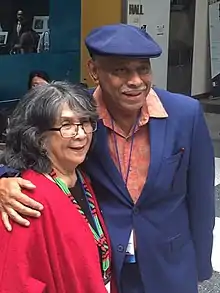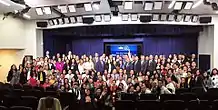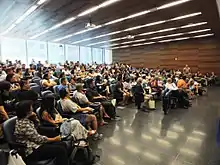Filipino American National Historical Society
The Filipino American National Historical Society (FANHS) is an organization that documents Filipino American history.
History

Founded on 26 November 1982 in Seattle, Washington by Dorothy Laigo Cordova and her husband Fred Cordova, the Filipino American National Historical Society (FANHS) is a community-based organization whose mission is “to promote understanding, education, enlightenment, appreciation, and enrichment through the identification, gathering, preservation, and dissemination of the history and culture of Filipino Americans in the United States” with the goal “...to preserve, document, and present Filipino American history and to support scholarly research and artistic works which reflect that rich past...”
FANHS was first chartered in Washington State on 7 January 1985. The national office and archives are housed in Seattle, and is an informational resource on Filipino Americans for:
- community organizations
- primary and secondary schools, colleges, and universities
- local and national museums and historical associations
- independent authors, playwrights, and filmmakers
- teachers, students, and scholars
The first board of trustees was elected with 27 members from 12 states on 1 November 1986. In the same year, Fred Cordova, who was the founding president of FANHS, created the National Pinoy Archives. Dorothy Cordova is the founder and serves as executive director.
Past projects include the video Filipino Americans Discovering Their Past for the Future,[1] the pictorial essay Filipinos: Forgotten Asian Americans;[2] and various regional publications and photo exhibits. FANHS also contributed significantly to the Smithsonian traveling exhibit Singgalot: The Ties That Bind which documents the history of Filipino Americans in the US.[3]
Filipino American History Month
Under the leadership of Fred Cordova, FANHS established Filipino American History Month (FAHM) in 1992.[4] Since then, FAHM has been recognized by several states like New York,[5] California,[6] Hawaii,[7] and Minnesota.[8] In 2009, the U.S. Senate and Congress proclaimed October as Filipino-American History Month.[9] In 2015 and 2016, President Obama officially recognized FAHM in October with a celebration in the White House.[10]

Biennial National Conferences
Since 1987, FANHS has sponsored national conferences (later ratified as a biennial event) where community folks of all ages and from all walks of life gather to share and present research, network with other Filipino Americans, and honor those who have produced ground-breaking innovative work in the field of historical research and analysis.[11] Past conference host cities include: 1987 – Seattle, Washington 1988 – New Orleans, LA, 1990 – Sacramento, CA, 1992 – Chicago, IL, 1994 – San Francisco, CA, 1996 – New York, NY, 1998 – Manila, Philippines, and 1998 – Portland, OR.[11]
The 2000 national conference was hosted by the Hampton Roads Chapter of FANHS, held June 28 - July 1, 2000 in Virginia Beach, Virginia. The theme, "Forever Pinay/Pinoy: Legacies of the Filipino American Experience".[12]
The 2002 biennial national conference was hosted by the Los Angeles Chapter of FANHS, and held in late July 2002 at Loyola Marymount University in Los Angeles, California. With hundreds in attendance, one of the keynote speakers was Vicki Manalo Draves - first Filipina/ Asian American Olympian and gold medalist.[13]
The 2004 biennial national conference was hosted by the St. Louis Chapter (Chapter of the Filipino American National Historical Society, in St. Louis, Missouri during the Saint Louis Exposition centennial (1904) and the Louisiana Purchase bicentennial (1803). Following the Spanish–American War, the United States acquired new territories such as Guam, the Philippines, and Puerto Rico. Some natives from these areas were brought to be on "display" at these expositions. Such displays included the Apache of the American Southwest and the Igorot of the Philippines, both of which peoples were dubbed as "primitive".[14]
The 2006 biennial national conference was hosted by the Filipino American Historical Society of Hawaii, in Honolulu, Hawaii. The 2006 national conference in Hawaii was also a centennial celebration as it was in 1906 when the first wave of Sakadas (farm workers) landed in Hawaii.[15]
The 2008 biennial national conference was hosted by the Alaska Chapter (Chapter 17) of the Filipino American National Historical Society, in Anchorage, Alaska during the week of the 4th of July holiday (July 3, 4 and 5, 2008), and featured the theme "Lure of the Salmon Song" referring to the tens of thousands of Filipino Alaskeros who worked in the Alaskan canneries since 1915.
The 2010 biennial national conference was coordinated by Dr. Joan May Cordova and was held July 21–24, 2010, in Seattle, Washington, and featured the theme, "A Quest for Emergence: A Retrospective." [16]
The 2012 biennial national conference was held June 28–30, 2012, in Albuquerque, New Mexico, and featured the theme "Resilience: A Filipino Legacy in a Global Community."[17]
The 2014 biennial national conference was coordinated by Dr. Judy Patacsil and was held July 31–August 2, 2014, in San Diego, California, and featured the theme "Kapwa: Moving Forward in Unity."[18] A memorial service was held to honor FANHS Founding President Fred Cordova who had died several months prior.[19]
The 2016 biennial national conference was coordinated by Dr. Kevin Nadal and was held June 22–25, 2016, in New York City, New York. The theme was "A Pin♥y State of Mind: Building with Our Roots." Speakers included Jose Antonio Vargas, Ali Ewoldt, Paolo Montalbán, Joe Bataan, Honorable Lorna G. Schofield, Geena Rocero, Ernabel Demillo, Mia Alvar, Jaygee Macapugay, E.J.R. David, Nicole Ponseca, and others. The event gathered 700 participants from all over the country [20]
As of 2018, FANHS has 35 chapters across the country. Each chapter is responsible for collecting historical documentation, memorabilia, and artifacts in their respective areas.[21]

FANHS National Museum
The city of Stockton was chosen as the future site for the Filipino American National Historical Museum by the FANHS Board of Trustees at the 1994 Conference held in San Francisco.[22] In 2015, the museum opened in Stockton's Little Manila.[23]
References
- http://caamedia.org/films/filipino-americans-discovering-their-past-for-the-future/
- Cordova, Fred (1983). Filipinos, Forgotten Asian Americans: A Pictorial Essay, 1763-circa 1963. ISBN 0840328974.
- http://sfpl.org/?pg=2000278501
- "A Resolution: October is Filipino American History Month" (PDF). Filipino American Historical National Society. Retrieved 16 October 2018.
- "New York Governor Proclaims Filipinos American History Month".
- "California Filipino American History Month".
- Dreyer, Thelma (1 October 2008). "It's Filipino-American History Month!". Hawaii House Blog. Retrieved 15 October 2018.
- Mark Dayton (2012). "Filipino American History Month" (PDF). Governor of Minnesota. State of Minnesota. Retrieved 1 January 2018.
- Nadal, K. (2016). "Filipino American History Facts".
- Nadal, K. (2016). "Why we celebrate Filipino American History Month".
- "FANHS National Website".
- "Old Dominion University News".
- Ibanez, Florante (2013). Vicki Manalo Draves. Asian Americans: An Encyclopedia of Social, Cultural, Economic, and Political History. ISBN 9781598842401.
- Zwick, Jim (4 March 1996). "Remembering St. Louis, 1904: A World on Display and Bontoc Eulogy". Syracuse University. Retrieved 2007-05-25.
- "FANHS 2016 Conference Booklet" (PDF).
- "FANHS is 25 Blog".
- Jamero, P. (2012). "FANHS 14th Biennial National Conference, Albuquerque NM".
- "15th biennial FANHS Conference in San Diego".
- Ibanez, F. (2014). "Fil-Am history conferees celebrate 'togetherness'".
- Ibanez, F. (2016). "Fil-Am historians, activists gather in New York".
- http://fanhs-national.org/filam/chapters
- "Archived copy". Archived from the original on 2013-09-02. Retrieved 2013-02-20.CS1 maint: archived copy as title (link)
- Conclara, Rommel (5 March 2015). "Fil-Am museum to open in California". ABS-CBN News. Retrieved 6 March 2015.
External links
1. http://www.fanhs.net Filipino-American National Historical Society network website
2. http://www.fanhs-national.org Filipino American National Historical Society, national organization's website
3. https://web.archive.org/web/20080217202208/http://fanhs17.com/ Alaska chapter of the Filipino American National Historical Society, Chapter 17
4. http://fanhsac.tripod.com Filipino American National Historical Society Sacramento-Delta Chapter, Chapter 2
5. http://www.fanhs-santaclara.org Filipino American National Historical Society, Santa Clara Valley Chapter, Chapter 8
6. http://www.fanhs-nyc.org Filipino-American National Historical Society Metropolitan New York Chapter website
7. http://www.fahsoh.org Filipino-American Historical Society of Hawaii website
8. Interview with Fred and Dorothy Cordova, from the Seattle Civil Rights and Labor History Project
9. Maria Schenk Papers. 1975. Includes interview with Fred Cordova.